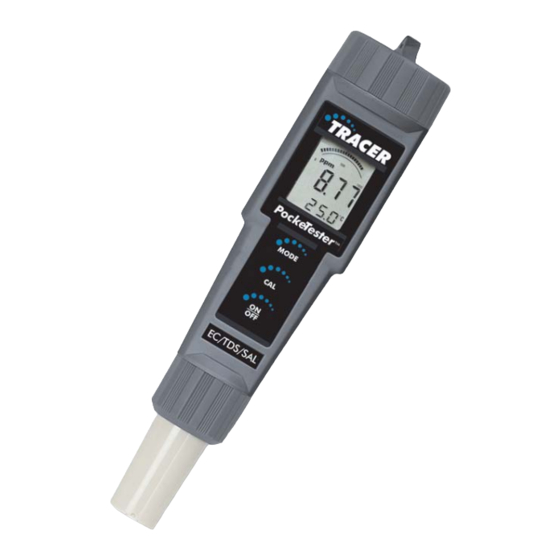
Table of Contents
Advertisement
Quick Links
Advertisement
Table of Contents

Summary of Contents for LaMotte POCKETESTER EC/TDS/SAL TRACER
- Page 1 EC/TDS/SAL TRACER POCKETESTER ä Waterproof Series CODE 1749...
-
Page 3: Table Of Contents
TRACER EC/TDS/SAL POCKETESTER • CODE 1749 TABLE OF CONTENTS Introduction ......4 Specifications . -
Page 4: Introduction
Introduction Congratulations on your purchase of the EC/TDS/SAL (Electro Conductivity/Total Dissolved Solids/Salinity) TRACER PockeTester. The TRACER is a revolutionary, first of its kind measurement device that offers direct reading of conductivity, TDS and salinity with one electrode. Careful use and maintenance will provide years of reliable service. -
Page 5: Contents
Contents EC/TDS/SAL TRACER PockeTester Kit Code 1749 Includes: Sample Cup w/cap Not sold individually. See below. Parts & Accessories EC/TDS/SAL Replacement Electrode Code 1765 Weighted Stand w/Sample Cups (5) Code 1746 Sample Cups w/caps (24) Code 1745-24 Conductivity Standard, 84 mS Code 6312-G Conductivity Standard, 1413 mS Code 6354-G... -
Page 6: Meter Description Front Panel Description
Meter Description Front Panel Description 1. Battery compartment cap 2. LCD Display 3. MODE/HOLD button - change mode, hold data, store data 4. CAL button - calibration, change temperature units, recall data 5. ON/OFF button 6. Electrode Collar 7. Electrode (Note: The Electrode cap is not shown) TRACER Display 1. -
Page 7: Basic Operation Powering The Tracer
Basic Operation Powering the TRACER The tab located in the battery compartment must be removed before use. If the batteries are weak, the BAT indicator will appear on the display. Press the ON/OFF key to turn the TRACER on or off. The auto power off feature will shut the TRACER off automatically after 10 minutes after the last button push. -
Page 8: Changing The Displayed Tempreature Units
Changing the Displayed Temperature Units To change the displayed temperature units between °C or °F: 1. With the TRACER off, press and hold the CAL button. 2. Press the ON/OFF button. When SELF CAL appears in the display, release the CAL button. Data Hold Press the MODE/HOLD button to freeze the current reading. -
Page 9: Testing Getting Started
TESTING Getting Started 1. Twist off the battery compartment cap to access the battery tab. Remove the plastic tab before first use. 2. Remove the cap from the bottom of the TRACER to expose the electrode. Changing the Measurement Function The meter can be set to measure Conductivity, TDS (ppm), TDS (mg/L) or Salinity. -
Page 10: Measurement
Measurement 1. Fill a sample cup to the 20 mL line with the test sample. Sample depth must be greater than or equal to 1.5 inches. 2. Immerse the TRACER electrode in the sample. Make sure the electrode is completely submersed. 3. -
Page 11: Storing Readings
9. Stir the filtrate with the electrode to create a homogeneous solution. 10. Gently stir the filtrate with the electrode. Read the TDS value of the filtrate from the display. 11. Rinse the electrode in distilled water. Replace the cap. Storing Readings 1. -
Page 12: Calibration
CALIBRATION Meter accuracy verification should be performed on a periodic basis as needed. If calibration is required, the meter must be in the conductivity mode to perform the calibration. The meter can perform a calibration and store the data for each of the three ranges – low, medium and high. The automatic calibration recognition procedure will recognize conductivity standards of 84mS (Low), 1413mS (Medium) or 12,880mS (12.88mS) (High). -
Page 13: Maintenance Storage
MAINTENANCE Storage 1. Rinse the electrode in distilled or deionized water. 2. Store the electrode dry with the cap on. Battery Replacement For maximum battery life, use battery style SR-44 (Silver Oxide) such as EnergizerÔ No. 356 or DuracellÔ No. 303/357. 1. -
Page 14: Troubleshooting
TROUBLESHOOTING Problem Check Action Power on but no Batteries Insert batteries display Verify correct polarity Replace batteries Unstable readings Electrode Immerse probe more deeply in sample Remove air bubbles caught under electrode Replace electrode Unexpected results Standards Calibrate with fresh standards Calibrate with standard in range similar to sample Display frozen... -
Page 15: Warranty
Warranty LaMotte Company warrants this instrument to be free of defects in parts and workmanship for one year from date of shipment (a six month limited warranty applies on electrodes and cables). If it should become necessary to return the instrument for service during or beyond the... - Page 16 LaMOTTE COMPANY Helping People Solve Analytical Challenges ® PO Box 329 • Chestertown • Maryland • 21620 • USA 800-344-3100 • 410-778-3100 (Outside U.S.A.) • Fax 410-778-6394 Visit us on the web at www.lamotte.com 1749-MN · 06/04...
















Need help?
Do you have a question about the POCKETESTER EC/TDS/SAL TRACER and is the answer not in the manual?
Questions and answers